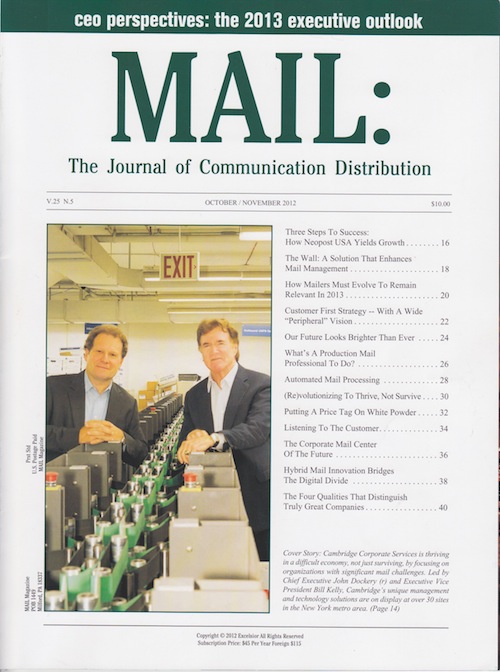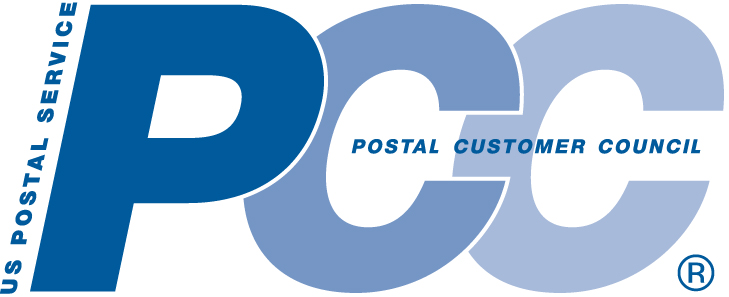Interview with leading mail screening and processing company Cambridge Corporate Services
Successful operation of a large corporate mail center requires a variety of management skills, mostly to do with staffing, proficiency and procedures. The central challenge for large mail centers is to recruit, hire, and train the best team possible capable of dealing with fast-moving mountains of mail while avoiding the inevitable hazards associated with misdirected mailpieces.
Working fast is not good enough. Working smart is tougher than it looks due to the presence of so many opportunities for error lurking along the path to completion.
As most successful service providers have come to realize, it’s not the mistakes that matter, for there is no such thing as a perfect system. It’s what you do about them that marks you as a mail service professional.
This article highlights the successful implementation of brilliant defensive strategies developed by Cambridge Corporate Services (“Cambridge”), a mail services outsourcer thriving in the shark-infested waters of lower Manhattan, the world’s financial district.
Founded by John Dockery in 1988, this mature mail service provider is headquartered at 26 Broadway employing over 500 full-time employees stationed at over 30 sites in the New York metro area with operations ranging in size from 2 to 170 employees.
“We distinguish ourselves by focusing on accounts with significant mail challenges. This strategy enables us to develop methodologies easily applied to mail operations in many industries.”
Mr. Dockery is familiar with the importance of a potent defensive strategy in any endeavor, having played for the New York Jets as a Defensive Back from 1968 through 1971, including Super Bowl III, followed by the Pittsburgh Steelers from 1972 through 1974, also as a Defensive Back.
Cambridge offers a full range of mail services including mail center management; records management; off-site mail processing and screening; messenger, trucking and package intercept; administrative support; and digital scanning and processing.
As Bill Kelly, Executive Vice President explains, “While Cambridge competes with all of the ‘traditional’ mail service outsourcers, we distinguish ourselves by focusing on accounts with significant mail challenges. This strategy enables us to develop methodology easily applied to mail operations in many industries, especially financial.”
For most of the Cambridge clients, incoming mixed mail is not comprised of routine business correspondence. Incoming mail for a typical Cambridge client consists of large volumes of highly sensitive financial documents, often critical to the completion of a significant business transaction somewhere else in the world. One delayed or misdirected mail piece can result in substantial for the client or others.
Chain of custody awareness and strict compliance with state and federal regulations are paramount in the development of a Cambridge service offering.
From its inception, Cambridge has relied on the development of proprietary mail tracking software coupled with highly reliable and industry-proven mail -handling equipment based on the following design objectives:
1. To deploy automation wherever it a n be shown to improve mail-handling productivity and cost-effectiveness; and
2. To achieve and then maintain the highest level of management visibility for all mission-critical mailpieces, regardless of its mail classification but rather by its source and destination or its contents.
For Cambridge, it’s not enough to simply receive, sort and distribute incoming mail. Each mailpiece has to be understood before it starts to move within the internal system.
For example, many mission-critical mailpieces arrive addressed to specific persons or departments, and yet they must be forwarded to a designated alternate recipient for preprocessing and approval. The decision trees for this interdiction process are complex and constantly varying. Further more, the piece counts received, diverted for pre-processing and approval, and ultimate delivery must balance on a daily basis to the mailpiece.
Since Cambridge actively seeks clients with extraordinary incoming mail challenges, they also prefer to deal with clients who are willing to collaborate on a mutually beneficial solution. Kelly states proudly that “Cambridge will work with whatever technology is provided by the client, but we will also offer customized solutions designed to fix a particular problem. We prefer to establish long term relationships built on trust, experience and expertise. The longer we work with our clients, the more we both learn about their mail, and this in turn leads to spectacular results in mail processing efficiencies.”
The Cambridge Playbook
The details behind each of the client solutions are obviously confidential. However, lessons can be learned by observing from a distance. What follows is a brief summary of the Cambridge strategy for dealing with incoming mail.
1. Think inside the envelope.
For most mail service organizations, they complete their assigned duties without ever opening the envelope. By doing so, they doom themselves to be mere couriers, not business partners. Business mail, with the exception of the Chai1man of the Board, belongs to the enterprise. Why stop at the envelope’s edge? At Cambridge, Omation 206 Extractors are used to open mail, and Kodak scanners are used to scan and capture the contents, thus launching an entirely new vista for maiI processing from that point forward.
2. Sort first by intent not by address.
Use sophisticated scanning and parsing logic to determine the intended purpose of the mailpiece. Let that determination set the parameters for culling out familiar patterns of mail flow. At Cambridge, mail is often scanned and separated by categories such as a) known sender/receiver pairs; b) known recipients with no requirements for preprocessing and approval; c) unknown recipients; d) unwanted recipients; and other possibilities.
3. Don’t just move mail, remember it.
For many mail center managers, happiness is an empty mailroom at the end of the day. No care or concern is ever given to who got what mail, so long as it all gets delivered. At a Cambridge site, this would be an intolerable attitude. Cambridge tracks and records every mailpiece using a custom identifier recorded in the Intelligent Mail Barcode (IMB) symbology, affixed to the reverse side by the Tritek sorters.
4. Know the facts before engaging a disappointed client.
If and when a service failure occurs, prepare yourself for a helpful dialogue, as opposed to a firing squad. The key to success in maintaining a constructive relationship is to quickly eliminate the “piling on” with unsubstantiated accusations. Since a Cambridge site manager is armed with a daily report showing who got what and when, the root cause of a service failure can quickly be determined and a corrective measure instituted.
5. Engage the team in new developments.
Site managers and team captain should engender an attitude among the staff members that automation enables them to do a better job, as opposed to the elimination of work. Once the team members buy into the value of automation, they soon become valuable contributors to additional deployments or enrichments.
6. Close the loop on sort strategies.
The database of accurate addresses and interdiction decisions should constantly be nurtured through daily use. The Tritek
91 -5 sorters in use at Cambridge sites are constantly monitored for opportunities for improvement in the databases. Tritek worked closely with Cambridge to enable this enrichment process, often testing new strategies on smaller ones before going live with the full days input. Mr. Kelly summarizes the Tritek contributions saying, “Tritek and Cambridge work well together. We deploy automation, in this case high-speed letter sorters, to understand the peculiarities of our client’s incoming mail.”
7. Stay abreast of trends in mail processing.
Cambridge began offering off-site mail scanning and processing in 2001, just after the 9/11 and anthrax events. “Off-site scanning creates an air-gap between initial induction and a client’s core operation, thereby mitigating the risk of costly business disruptions,” said Mr. Kelly. “Our 2011 volumes through off-site processing were over 7.8 million mailpieces and 600,000 accountable pieces.”
For Cambridge, the seasons have been good for everyone involved. Looking back over the past 24 years, Mr. Dockery sees “a constant growth pattern, with minimal disruptions along the way. We built this organization one client at a time by playing a truly quality game day after day.”
Article was original posted by Mail: The Journal of Communication Distribution by Richard Pavely









